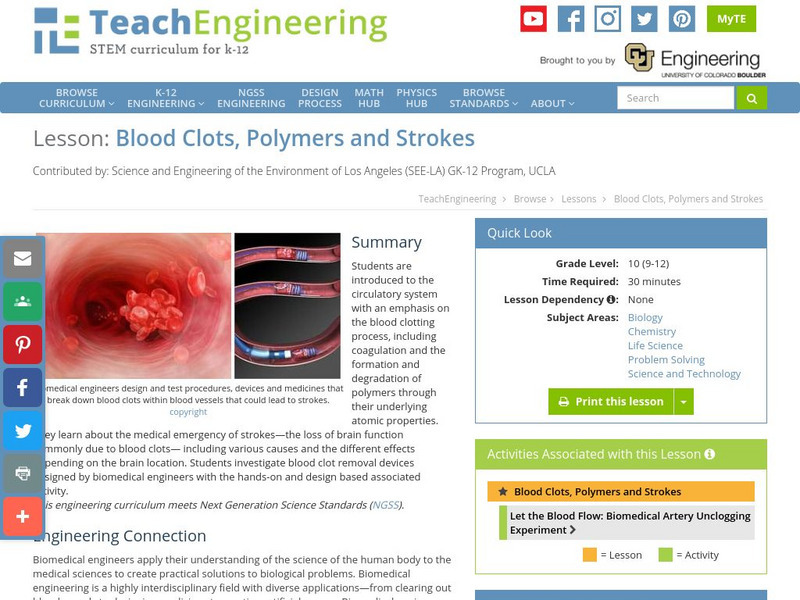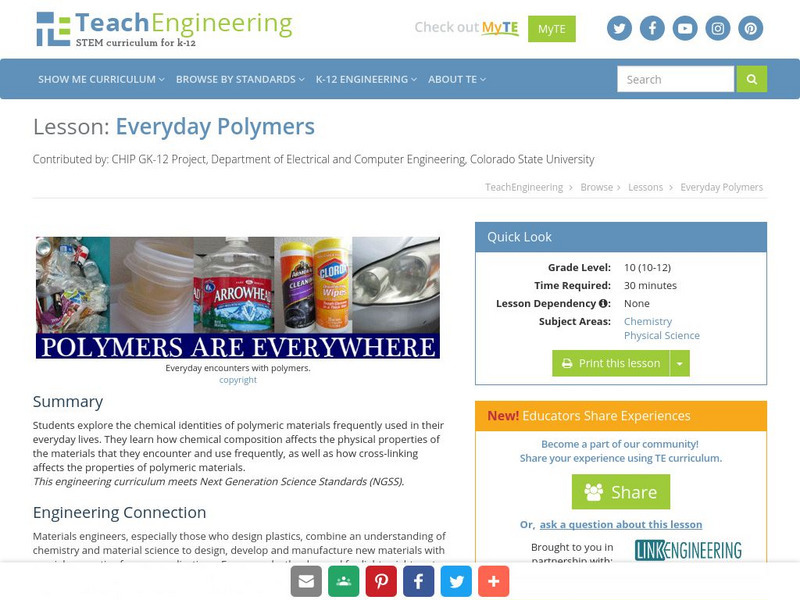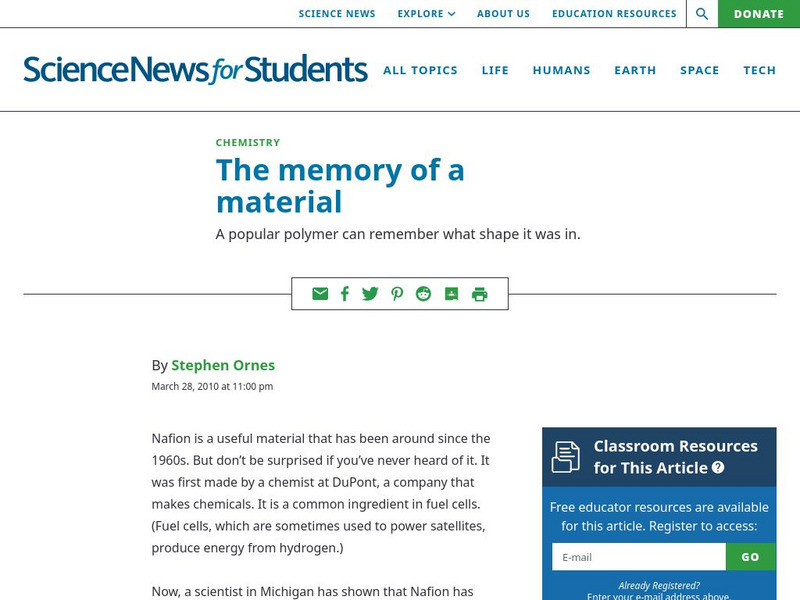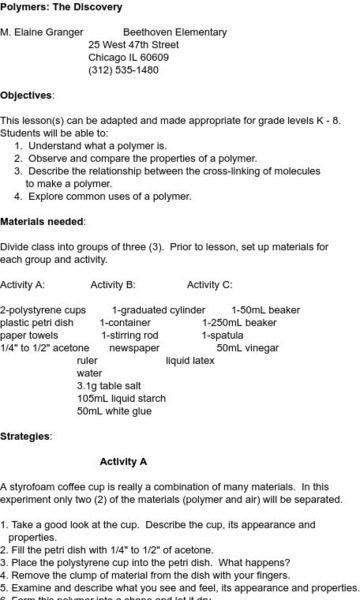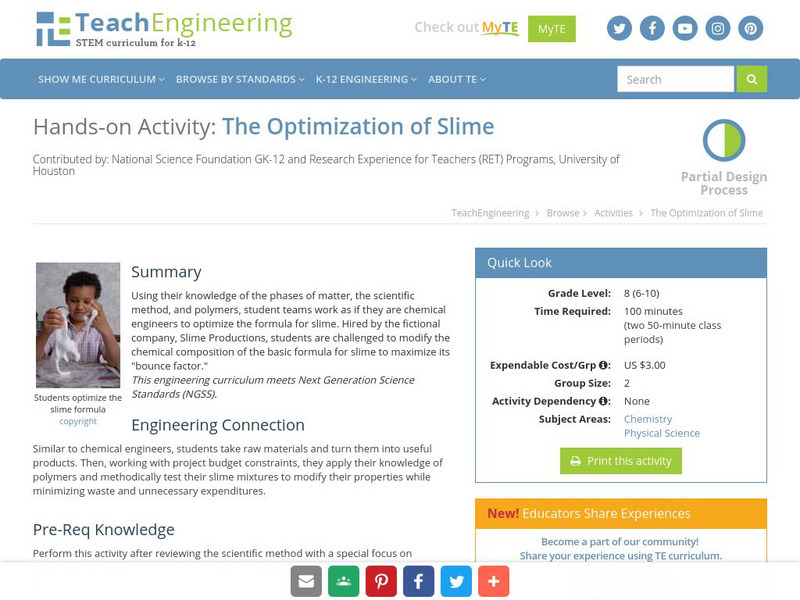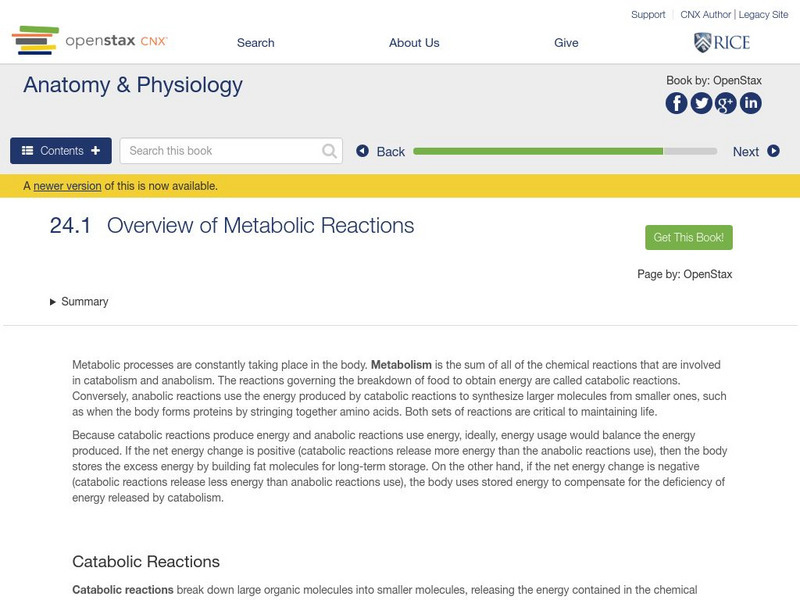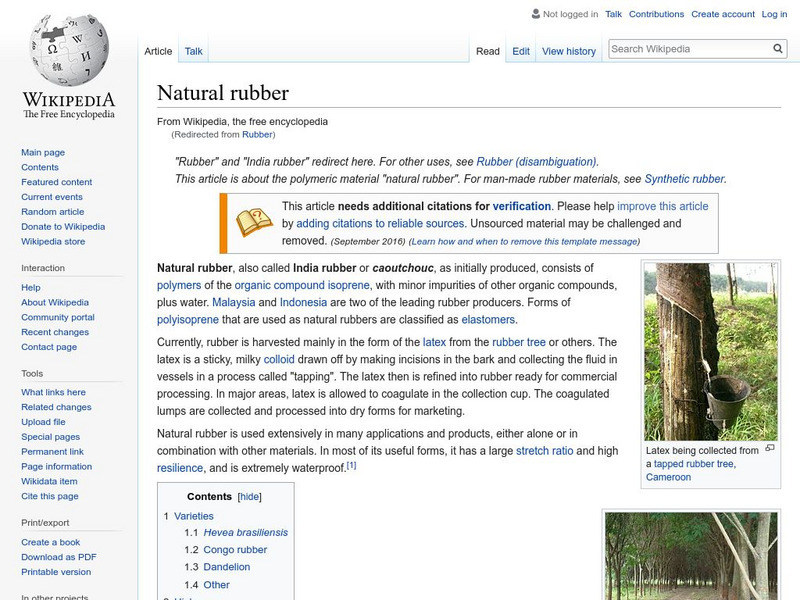Hi, what do you want to do?
Science Education Resource Center at Carleton College
Serc: Plastic Polymers: Investigating Their Flexibility
Students will use their prior knowledge about changes of matter to develop a hypothesis to test the physical properties of materials such as plastic (polymers) and how its chemical properties allow it to have unique physical properties.
Other
Educational Innovations: Diaper Polymer Activities [Pdf]
What can you do with diaper polymer? Check out these six quick student experiments involving the chemical used in diapers.
Math Science Nucleus
Math/science Nucleus: Polymer Storybook
This animation discusses polymers and the properties of polymers in a storybook format. The story covers polymers both plastic and natural, and provides interesting information.
Concord Consortium
The Concord Consortium: Molecular Workbench Linear vs. Branched Polymers
View the differences in intermolecular interactions between linear and branched polymers.
TeachEngineering
Teach Engineering: Creepy Silly Putty
Students learn about viscoelastic material behavior, such as strain rate dependence and creep, by using silly putty, an easy-to-make polymer material. They learn how to make silly putty, observe its behavior with different strain rates,...
Discovery Education
Discovery Education: 3 M Young Scientist Lab: Sandwich Bag Dart Board
Sharp Pencils and water-filled sandwich bags demonstrate the nature of certain polymers.
McREL International
Mc Rel: Glue Polymer (Whelmer #15 Learning Activity)
An easy to do activity that investigates the basic principles behind chemical bonding. The activity is written in lesson plan format that meets NSES standards.
TeachEngineering
Teach Engineering: Blood Clots, Polymers and Strokes
Students are introduced to the circulatory system with an emphasis on the blood clotting process, including coagulation and the formation and degradation of polymers through their underlying atomic properties. They learn about the...
TeachEngineering
Teach Engineering: Everyday Polymers
Students explore the chemical identities of polymeric materials frequently used in their everyday lives. They learn how chemical composition affects the physical properties of the materials that they encounter and use frequently, as well...
Concord Consortium
Concord Consortium: Stem Resources: Plastic Forces
This simple interactive tool lets students explore what happens to the long molecular chains in a plastic polymer material when forces of varying intensity are exerted on it.
Society for Science and the Public
Science News for Students: The Memory of a Material
Describes the properties of a synthetic polymer, Nafion, which can 'remember' shapes that it takes, based on the temperature.
Science is Fun
Science Is Fun: Gluep Solid or Liquid?
In this experiment, students create a polymer substance called Gluep, then investigate its properties. Includes a detailed explanation of how the polymer molecules bond together to form the plastic.
Museum of Science
Museum of Science and Industry: Online Science: Activities: Make Slime
Step-by-step instructions, with photos, of how to create slime made of polymer chains using Borax and white glue.
CK-12 Foundation
Ck 12: Chemistry: Materials
[Free Registration/Login may be required to access all resource tools.] Discussion of the design and production of new materials such as polymers and liquid crystals.
Maryland Science Center
Maryland Science Center: Bouncy Balls [Pdf]
Use simple materials in a chemical reaction to create a bouncy ball, and learn about long-chain polymers.
Science and Mathematics Initiative for Learning Enhancement (SMILE)
Smile: Polymers: The Discovery
A simple lab activity which introduces the field of polymer chemistry. Includes the use of polystyrene in a neat reaction.
Concord Consortium
Concord Consortium: Science of Atoms and Molecules: Nucleic Acids and Proteins
Through this activity, students work with macromolecules, proteins and nucleic acids. The focus is on the atomic structure of proteins, how linear polymers are made, and the surface charges of the resulting polymers. . Multiple-choice...
TeachEngineering
Teach Engineering: The Optimization of Slime
Using their knowledge of the phases of matter, the scientific method, and polymers, student teams work as if they are chemical engineers to optimize the formula for slime. Hired by the fictional company, Slime Productions, students are...
US Department of Energy
U.s. Department of Energy: Fuel Cell Technologies Program: Fuel Cell Animation
A series of animated illustrations show how a polymer electrolyte membrane fuel cell works. PEM fuel cells are the most common type used in flex-fuel vehicles.
OpenStax
Open Stax: Anatomy & Physiology: Overview of Metabolic Reactions
Students discuss the role of polymers, monomers, and ATP in metabolism, and then describe the hormones that regulate anabolic and catabolic reactions.
Science Buddies
Science Buddies: Slime Chemistry
Have you ever wondered how fun toys like Silly Putty, Gak, and Slime are made? These products are so much fun because of the properties of polymers, which make them delightfully bouncy, stretchy, sticky, moldable, breakable, hard, soft,...
Science Bob Pflugfelder
Science Bob: Homemade Slime!
Contains a procedure for creating slime -- a polymer formed by mixing water, borax, Elmer's glue, and food coloring. Following the procedure, the site contains a brief description of what polymers are.
Wikimedia
Wikipedia: Nylon
Wikipedia provides detailed information on nylon, a synthetic polymer. Includes nylon's uses, history, and products.
Wikimedia
Wikipedia: Rubber
Wikipedia provides detailed information on rubber, a hydrocarbon polymer. Includes information on the composition and uses of rubber.
Other popular searches
- Polymerase Chain Reaction
- Condensation Polymerization
- Polymers Plastics
- Monomers and Polymers
- Polymer Science
- Plastic Polymer
- Polymer Clay
- History of Polymers
- Monomers & Polymers
- Disposal of Polymers
- Making Polymers
- Uses of Polymers






![Educational Innovations: Diaper Polymer Activities [Pdf] Activity Educational Innovations: Diaper Polymer Activities [Pdf] Activity](https://static.lp.lexp.cloud/images/attachment_defaults/resource/large/FPO-knovation.png)



